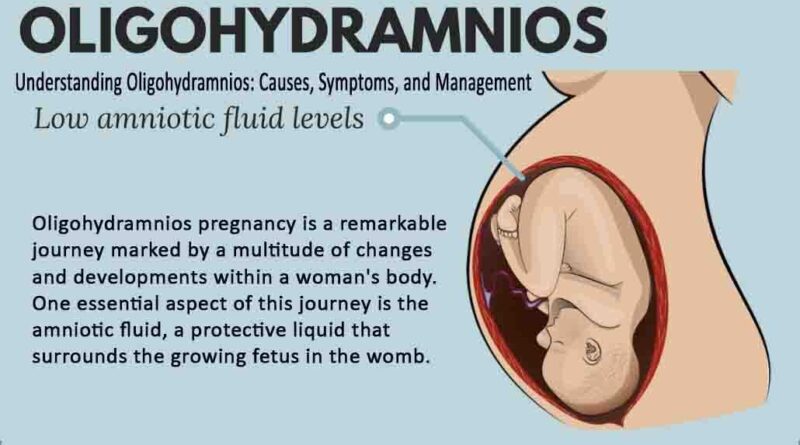Understanding Oligohydramnios: Causes, Symptoms, and Management
Oligohydramnios, a condition characterized by a deficiency of amniotic fluid in the womb, is a subject of significant concern for both medical professionals and expectant mothers. This condition can potentially impact the health and development of the fetus, making it essential to comprehend its causes, symptoms, and appropriate management strategies. In this comprehensive guide, we delve into the depths of oligohydramnios, shedding light on its various aspects to provide a better understanding for all stakeholders involved.
What is Oligohydramnios?
Amniotic fluid plays a vital role in supporting the development of the fetus throughout pregnancy. It cushions the fetus, helps maintain a stable temperature, prevents adhesions, and facilitates fetal movement. Oligohydramnios, often referred to as low amniotic fluid levels, occurs when the volume of amniotic fluid is below the normal range for a given gestational age. This condition can lead to complications that warrant careful monitoring and, in some cases, medical intervention.
Causes of Oligohydramnios

Understanding the potential causes of oligohydramnios is crucial for effectively managing the condition. There are several factors that can contribute to decreased amniotic fluid levels, including:
- Dehydration: Maternal dehydration can reduce the amniotic fluid volume, underscoring the importance of proper maternal hydration during pregnancy.
- Fetal Kidney Problems: The fetus’s kidneys play a pivotal role in producing amniotic fluid. Any abnormalities in kidney development or function can lead to reduced fluid levels.
- Placental Dysfunction: A malfunctioning placenta can impact the exchange of nutrients and waste products between the fetus and the mother, potentially leading to low amniotic fluid levels.
- Rupture of Membranes: The rupture of the amniotic sac prematurely can result in a gradual decline in amniotic fluid.
- Fetal Abnormalities: Certain congenital malformations can affect the fetus’s ability to produce or swallow amniotic fluid, causing oligohydramnios.
- Multiple Gestation: In pregnancies with multiple fetuses, there might be an increased risk of oligohydramnios due to greater demands on the available fluid.
Symptoms and Diagnosis
Oligohydramnios may not always present noticeable symptoms, making regular prenatal check-ups crucial for its early detection. However, in more severe cases, the following symptoms might be observed:
- Reduced fetal movements
- Measuring smaller than expected for gestational age
- Decreased fundal height (measuring smaller than expected for the stage of pregnancy)
To diagnose oligohydramnios, healthcare providers use various methods, including ultrasound imaging, to measure the amniotic fluid index (AFI). An AFI below 5 cm is generally considered indicative of oligohydramnios. Further diagnostic tests might be performed to identify any underlying causes.
Potential Complications
Oligohydramnios can give rise to a range of complications that impact both the mother and the fetus. For the fetus, these may include:
- Lung Development Issues: Amniotic fluid is essential for proper lung development. Insufficient fluid can lead to underdeveloped lungs, causing respiratory problems after birth.
- Musculoskeletal Abnormalities: Adequate amniotic fluid is necessary for the fetus’s movements, which promotes musculoskeletal development. Oligohydramnios can lead to conditions like clubfoot or limb contractures.
- Fetal Growth Restriction: Limited amniotic fluid can hinder the fetus’s growth, leading to a condition known as intrauterine growth restriction (IUGR).
- Cord Compression: Reduced fluid levels increase the risk of the umbilical cord becoming compressed during labor, potentially compromising the baby’s oxygen supply.
For the mother, oligohydramnios can contribute to complications such as placental abruption, increased risk of cesarean delivery, and the need for labor induction.
Managing Oligohydramnios
The management of oligohydramnios depends on its severity, underlying causes, and the gestational age of the fetus. Some management strategies include:
- Increased Hydration: In cases of mild oligohydramnios attributed to maternal dehydration, increasing fluid intake might help restore amniotic fluid levels.
- Fetal Monitoring: Regular monitoring of the fetus’s heart rate and movements is essential to ensure the baby’s well-being.
- Amnioinfusion: This procedure involves infusing sterile fluid into the amniotic cavity to increase fluid levels during labor. It can reduce the risk of cord compression and improve fetal oxygenation.
- Induction of Labor: In more severe cases, healthcare providers might recommend inducing labor to minimize risks associated with ongoing oligohydramnios.
- Cesarean Delivery: If the risks to the fetus’s health are significant, a cesarean delivery might be considered to avoid potential complications associated with vaginal delivery.
In the realm of prenatal care, understanding oligohydramnios is of paramount importance. The causes, symptoms, and management of this condition all play critical roles in ensuring the well-being of both mother and fetus. Early detection, regular prenatal check-ups, and open communication between expectant mothers and healthcare providers are essential elements in effectively managing oligohydramnios and their potential complications. As medical knowledge and technology continue to advance, the ability to provide optimal care for pregnancies affected by oligohydramnios will undoubtedly improve, offering hope for healthier outcomes for both mothers and their precious unborn babies.




